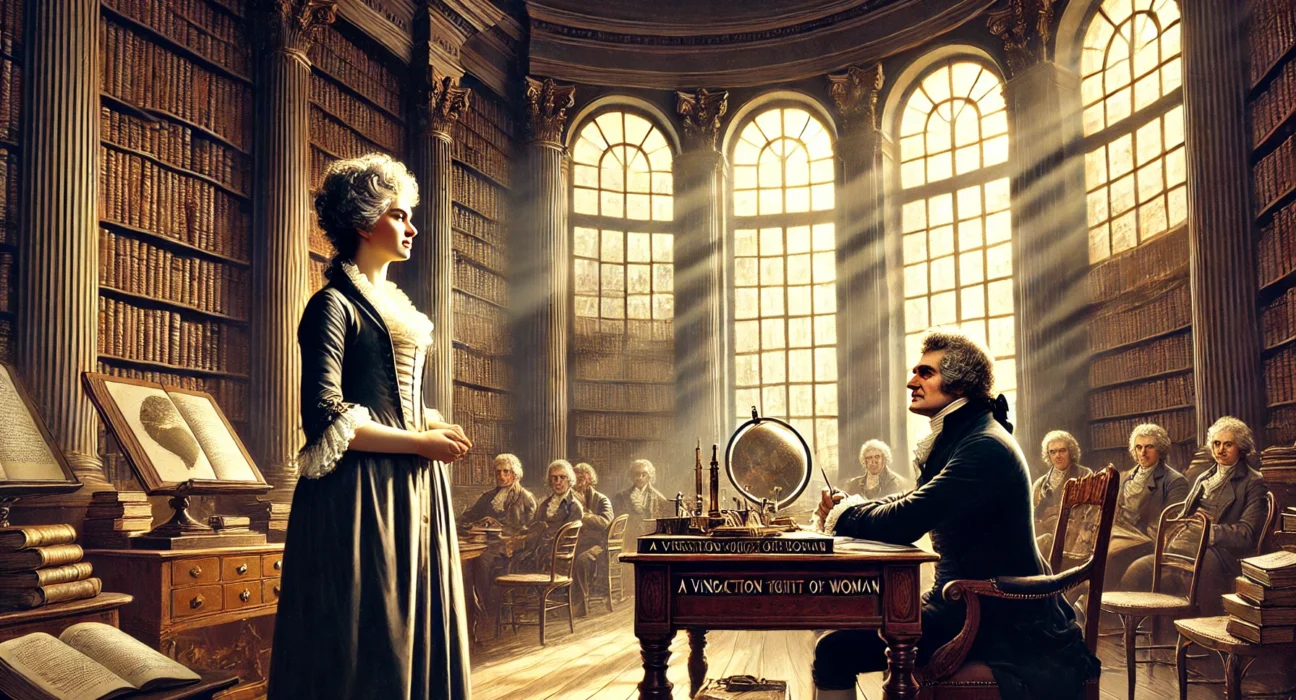A Vindication of the Rights of Woman is a revolutionary feminist work written by Mary Wollstonecraft and first published in 1792. This treatise advocates for gender equality, particularly emphasizing the need for women’s access to education and their ability to exercise rational thought. Wollstonecraft addresses societal norms that undermine women’s potential, arguing that women are not inherently inferior but are rendered subordinate by a lack of opportunities for intellectual development.
Plot Summary
In a time when society ordained that women remain confined to the delicate spheres of domesticity, one woman stood tall, challenging these norms with an unwavering belief in reason. Her name was Mary Wollstonecraft, a thinker of great conviction, and she set out to dismantle the foundations that had long kept women in a state of submission. Through her passionate arguments, she illuminated the path toward equality, using her sharp intellect as both weapon and guide. Her mission was clear: to vindicate the rights of women, to show that they were not mere ornaments meant to please men but rational beings deserving of the same opportunities for growth and virtue.
In the opening of her discourse, she surveys the world with a sorrowful gaze, recognizing that civilization has been unevenly distributed, favoring men and leaving women in a stunted, dependent state. She laments how education, which should be the great equalizer, has instead become a tool to subjugate women further, trapping them in frivolity and weakness. Like flowers that are overnurtured in rich soil, women, she contends, have been cultivated for beauty rather than strength. They are taught to be docile and alluring, qualities that may serve them in attracting male attention but fail them as human beings with intellectual and moral potential.
Her plea is not merely for equality but for the cultivation of virtue. She argues that without the ability to exercise their reason, women cannot be truly virtuous. How, she asks, can a woman be expected to act morally when she has not been given the tools to understand the principles of virtue? Wollstonecraft declares that both men and women must be educated in the same way, with the same emphasis on developing the mind. If men are taught to be rational and independent, why should women be kept in ignorance, their only value tied to their physical appearance and ability to charm?
Wollstonecraft turns her critical eye toward men like Jean-Jacques Rousseau, whose writings on the nature of women she finds particularly insidious. Rousseau, she notes, suggests that women are inherently different from men and should be educated only to please them. He asserts that women’s weakness is a natural quality, something to be nurtured. To Wollstonecraft, this is not only a grave misunderstanding of women’s potential but also a dangerous perpetuation of their oppression. She believes Rousseau, like many men of his time, confuses the natural differences between men and women with differences in capability. While she concedes that men are physically stronger, she firmly rejects the notion that women are intellectually or morally inferior.
At the heart of Wollstonecraft’s argument is the belief that the human mind, male or female, is capable of great things when it is allowed to flourish. She calls for a new system of education that focuses on strengthening the mind and body of women so that they can become better companions, mothers, and citizens. She rejects the idea that women should be content with their current lot—decorated, submissive, and idle. Instead, she envisions a society where women are active participants, exercising their reason and contributing to the progress of humanity.
Wollstonecraft paints a vivid picture of the consequences of this imbalance in education. Men, she argues, who marry women trained only to be charming and superficial, will inevitably tire of them. When the allure of youth and beauty fades, the lack of intellectual companionship will lead to dissatisfaction and unhappiness. The current system, she warns, not only fails women but men as well. By refusing to educate women properly, society robs men of true partners, capable of engaging in the deeper, more meaningful aspects of life. She appeals to men’s reason, urging them to see that the subjugation of women is not only unjust but also detrimental to their own happiness and the health of society.
But Wollstonecraft is not merely concerned with the intellectual equality of women. She also speaks of the moral consequences of denying women their rightful place as rational beings. When women are treated as objects, as beings whose worth lies solely in their beauty and charm, they are deprived of the opportunity to cultivate true virtue. Wollstonecraft sees this as a moral tragedy, one that affects not only individual women but society as a whole. Without virtue, she argues, society cannot truly progress. And without educating women, the mothers of future generations, how can virtue be passed on?
She contends that the power imbalance between men and women has corrupted both sexes. Men, accustomed to dominating women, are often tyrannical in their relationships, while women, taught to manipulate rather than reason, resort to cunning and deceit. This dynamic, she claims, degrades both parties. A true partnership, based on mutual respect and shared values, can only exist when both men and women are free to exercise their reason and pursue virtue.
Wollstonecraft’s vision for women is one of independence—not in the sense of rejecting family or domesticity but in reclaiming their rightful place as equal participants in the moral and intellectual life of society. She envisions a future where women, no longer shackled by the superficial expectations of femininity, can stand side by side with men, contributing to the greater good. This vision, she insists, is not a dream but a necessity for the advancement of civilization. Only when women are allowed to reach their full potential can society as a whole achieve true progress.
Her words are not just a defense of women’s rights but a call to revolutionize the way society views human potential. In seeking to raise women to their rightful place, she seeks to elevate all of humanity. Wollstonecraft’s conviction is clear: the path to a better, more just society lies in the education and empowerment of women, and in doing so, the chains that bind both men and women will be broken.
This is the vindication of woman—the belief that reason, virtue, and equality belong to all, regardless of gender, and that the future of humanity depends on recognizing this truth.
Main Characters
Mary Wollstonecraft (as the primary voice of the work): Although the text is a philosophical argument rather than a traditional narrative, Wollstonecraft presents herself as a key figure through her advocacy and critiques. She embodies the rational feminist who challenges social norms and campaigns for women’s rights. Her arguments are impassioned yet grounded in Enlightenment ideals of reason and equality.
Men of the Enlightenment: Figures such as Jean-Jacques Rousseau and Edmund Burke appear in her critiques, serving as symbolic representations of patriarchal thought. Wollstonecraft critiques Rousseau, especially for his beliefs about women’s education, arguing that his views perpetuate their subordination.
Women of Society: Although unnamed, Wollstonecraft frequently addresses women as a collective group, urging them to break free from the limitations imposed by a patriarchal society. She calls on them to seek education and rationality over superficial accomplishments that men value.
Theme
Education as a Path to Equality: Central to Wollstonecraft’s argument is the theme that women’s intellectual inferiority is not innate but the result of a lack of proper education. She stresses that both men and women should receive the same education, as rationality is the foundation of virtue and progress.
Critique of Femininity: Wollstonecraft dissects societal constructs of femininity, which she argues confine women to being delicate, submissive, and ornamental. She asserts that these roles, glorified by men, undermine women’s intellectual and moral agency, reducing them to “slaves” or “playthings.”
Reason vs. Emotion: Wollstonecraft frequently contrasts reason, which she associates with enlightenment and progress, with the emotional manipulation that society encourages in women. She believes that cultivating reason is essential for both sexes and that women’s emotional conditioning makes them unfit companions for rational men.
The Role of Virtue: Virtue, according to Wollstonecraft, must be the same for both men and women. She rejects the idea that women should strive only to be “pleasing” to men, arguing instead that they must pursue moral independence, grounded in reason and education.
Writing Style and Tone
Wollstonecraft’s writing is clear, forceful, and impassioned. Her tone ranges from rational and logical to indignant and fiery, especially when she criticizes societal norms that demean women. She uses rhetorical questions and direct addresses to the reader to engage and challenge conventional thinking, often appealing to universal principles of justice and reason. Despite the intensity of her arguments, her writing is grounded in Enlightenment ideals, showing a deep commitment to rational discourse.
Her language reflects her philosophical background, and she draws on analogies from nature and education to underscore her points. At times, her tone shifts into a moralistic register, particularly when she addresses women directly, urging them to rise above the superficial roles society has given them. Overall, Wollstonecraft’s style is a mix of persuasive rhetoric, philosophical reasoning, and passionate advocacy, making her work both an intellectual and emotional appeal for women’s rights.
We hope this summary has sparked your interest and would appreciate you following Celsius 233 on social media:
There’s a treasure trove of other fascinating book summaries waiting for you. Check out our collection of stories that inspire, thrill, and provoke thought, just like this one by checking out the Book Shelf or the Library
Remember, while our summaries capture the essence, they can never replace the full experience of reading the book. If this summary intrigued you, consider diving into the complete story – buy the book and immerse yourself in the author’s original work.
If you want to request a book summary, click here.
When Saurabh is not working/watching football/reading books/traveling, you can reach him via Twitter/X, LinkedIn, or Threads
Restart reading!








